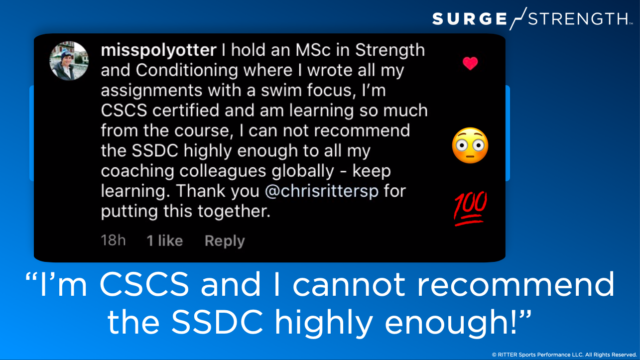Developing back half swimming speed is always an uphill challenge for swim coaches. Some feel that the answer is to make sure that swimmers have a ridiculously large aerobic base, hoping that hundreds of thousands of extra yards will give a swimmer that extra lift at the end of a race. At SURGE Strength, we take a different approach to developing back half swimming speed. Our programs and principles prioritize training a small volume of effective, power-based speed and resistance training instead of longer bouts of traditional aerobic-based training.
Below, we break down the science behind speed and power training. Then, we unpack how it translates to a faster “easy speed” in a race, which leads to better back half swimming speed. If you’re working less but still going fast at the beginning of a race, it’s much easier to come home strong when it hurts at the end – countless yards without resistance will only result in the ability to swim for a very long time without the speed and “umph” needed to make it count.
Energy System Development
You may have heard of sports-specific training. This refers to performing exercises that directly translate into the sport of swimming. However, it also applies to the intensity of training. It is important to train the swimmers’ energy system to match the demands of a race in order to make your dryland program “swim specific.”
The 3 Energy Systems
The body produces energy using three systems: the phosphagen system (also known as the anaerobic energy system), glycolysis (converting glucose to energy), and the oxidative system (also known as the aerobic energy system). The phosphagen system is responsible for brief, intense bouts of exercise. Perhaps you are swimming a short sprint (less than 6 seconds) or diving off the blocks.
Glycolysis is mostly used for longer sprints. For example, swimming a 200 free. Lastly, the oxidative system is utilized for longer bouts of exercise (over 2-3 minutes) and is what we use at rest.
It’s important to keep in mind that each of these energy systems play an important role and that all of them are working to some degree all the time. However, certain activities that require ATP to be converted into energy quickly will utilize more of the Phosphagen system. On the other hand, activities that demand more endurance will be dominated by the glycolytic and oxidative systems.
- ATP – Adenosine triphosphate: the intermediate molecule our body uses to produce and transfer energy
Since we want our swimmers to have both power and endurance, we should be tapping into all 3 of these energy systems in our dryland program. By simplifying dryland down to long sessions filled with steady state cardio, you are missing out on training 2/3 of the body’s ways of recruiting energy.
How to Train Smarter, not Harder
Remember, swimmers do not have an unlimited capacity of energy. Therefore, we want to maximize training time and dryland as efficiently as possible. In order to do this, focus on improving the anaerobic energy system.
Training in the anaerobic system in endurance-based sports such as swimming is often overlooked. However, swimmers benefit greatly from improving their anaerobic system regardless of their specialty stroke or event. This is because as the anaerobic system improves, so does the aerobic energy system.
Shifting the OBLA Curve
Let’s look at what the research says. OBLA stands for onset blood lactate accumulation. The graph below measures the level of blood lactate, which is associated with fatigue during training. The Y axis represents the concentration of blood lactate, while the x axis represents the intensity of exercise the athlete is performing. Through training the anaerobic energy system, the athlete accumulates less lactate at a higher training intensity. Therefore, they can train harder before becoming fatigued.

The main takeaway here is that both sprinters and endurance athletes benefit from anaerobic-based training. This is because they will feel less fatigued at a higher intensity. As a result, they will have a faster pace and will potentially be able to sprint faster.
How Does this Apply to Dryland?
Once you understand that anaerobic training is much more effective than aerobic-based training for all swimmers, it’s time to apply this philosophy to dryland. Anaerobic activity includes high effort and low duration activity. This means that if you’re prescribing “cardio” to your athletes, consider very short sprints with full recovery as opposed to telling them to go on a distance run.
When performing exercises such as plyometrics or heavy weight training, a good rule of thumb is 3 reps or less. Keep in mind that the intensity must be high in order to tap into the anaerobic energy system. This way, you are truly training power rather than just “conditioning” your athletes with sub-maximal effort. And in turn, your back half swimming speed is there when you need it.
In conclusion, train the energy system in which you want your swimmers to race. Use energy system development in dryland to prime your athletes’ anaerobic energy system. Then, their ceiling of potential increases, especially under fatigue (like at the end of their race). When your athlete finally gets to hop back in the pool post quarantine, their reserve capacity will be higher than if they spent their time performing steady state cardio. All anaerobic training translates into a faster “easy speed,” especially in the back half of race. Be intentional with this time spent relying on dryland. In addition, follow the science rather than doing what you’ve always done. Then, watch the results unfold when your swimmer’s back half of their race pushes them to the best they’ve ever been.
NEW – AT HOME DRYLAND WORKOUT
GET IT FOR FREE BY ENROLLING IN THE SURGE STRENGTH ACADEMY
JOIN OTHERS FROM AROUND THE WORLD THAT ARE
BECOMING SURGE STRENGTH DRYLAND CERTIFIED (SSDC)

BECOME SURGE STRENGTH DRYLAND CERTIFIED (SSDC)
BUILD BETTER ATHLETES TO GENERATE FASTER SWIMMERS
Courtesy of SwimSwam’s exclusive dryland training partner, SURGE Strength.
SURGE Strength, a strength training brand created by Chris Ritter, CEO of RITTER Sports Performance, aims to build better athletes and faster swimmers through dryland programs, and coaching education.







